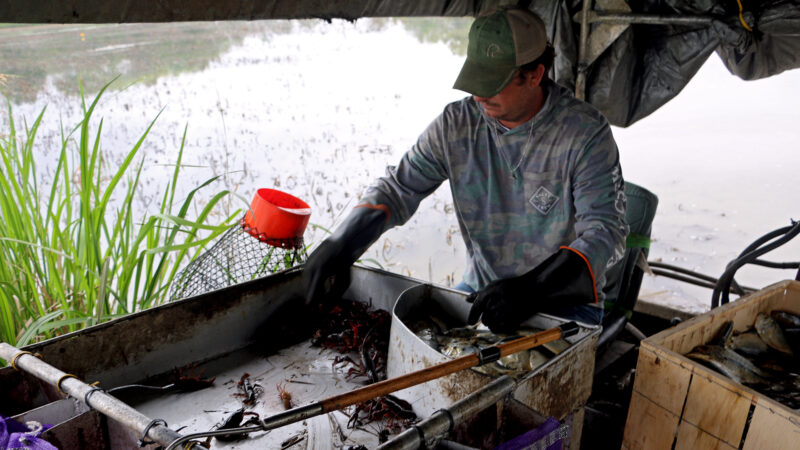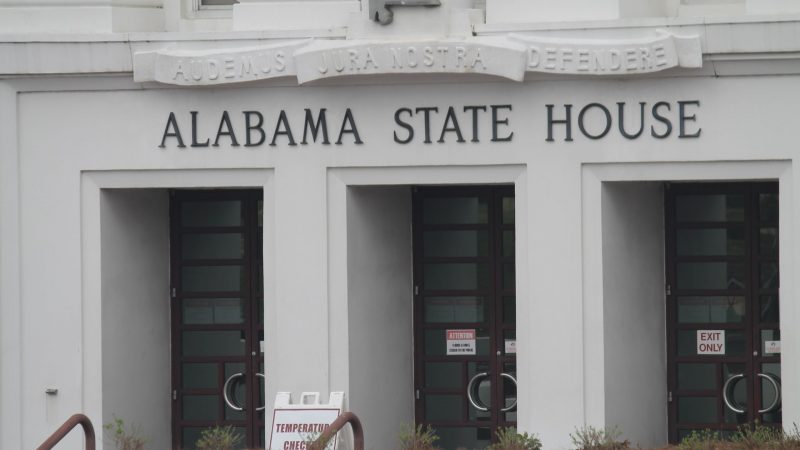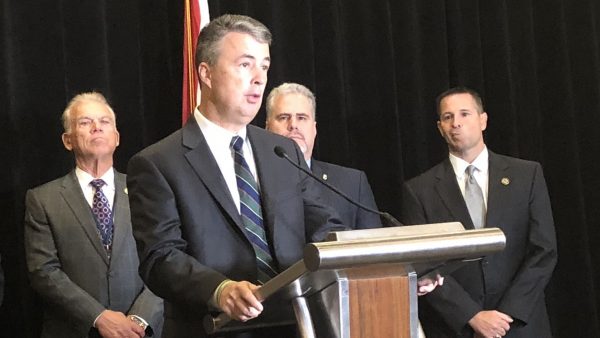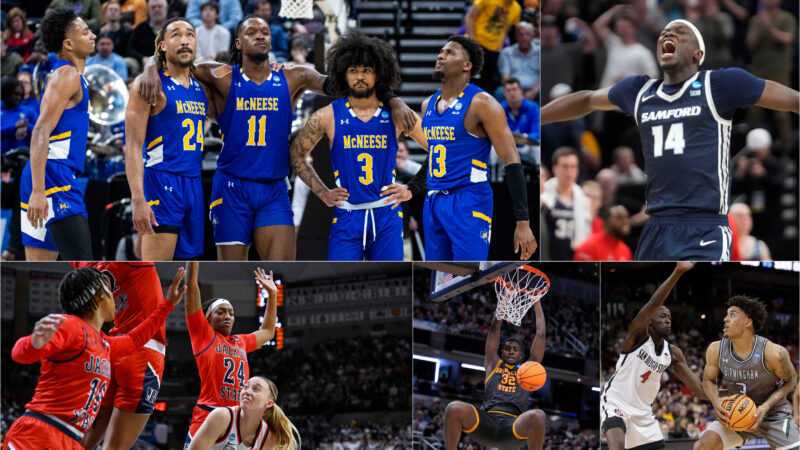Committee Could Decide the Fate of the Jefferson County Courthouse Murals
Back in September, the Birmingham chapter of the National Association for the Advancement of Colored Peoples (NAACP) petitioned the Jefferson County Commission to remove two murals that currently hang in the entrance way to the county courthouse.
Following the removal of the confederate flag from the South Carolina statehouse, members of the NAACP in Birmingham wrote that these murals “which were painted in the midst of Jim Crow and romanticize a racial hierarchy of slave labor, hatred and suffering in a government building that must be a place of justice and equality” should be taken down.
After a public meeting, the commission decided to call a committee of community members to decide what to do with the murals. They selected a 17 residents, including two County Commissioners, Joe Knight and Sandra Little Brown.
After the first committee meeting, Commissioner Joe Knight questioned whether the murals could feasibly be taken down.
“These art pieces are 17 1/2 foot by 8 foot, I don’t know that you can take them down and put them in an art museum, without destroying them,” explained Knight. “I don’t know that you can take them down and get them out of the doors of the courthouse, without taking out the doors of the courthouse.”
Knight says he doesn’t feel comfortable “destroying 85 year old art” and thinks the murals could be another stop along Birmingham’s Civil Rights tour.
Committee member Gwen Webb is clear. She says she and her community want the mural gone. Webb is a pastor, former policewoman and founder of Foot Soldiers International.
Webb argues that the courthouse is not a museum.
“The hall of justice is just what it is, people should be able to walk in and know that it is a truly a hall of justice in Birmingham, Alabama,” she explains. “You can’t expect justice when you are looking up and seeing full-fledged murals of black people, extremely dark black people in massah’s field picking cotton with men riding around over them with whips and the big antebellum plantation owner. Bigger than life. This is not the image of the new Birmingham, Alabama. This is not the image that people should see when they walk into the Jefferson County courthouse.”
Webb says the murals are “no value to the county” and “a disservice to the people.”
She says no one is trying to remove the South’s history of slave labor.
“You can’t delete history. We know historically that some of our parents and grandparents had to pick cotton in the cotton field. It was not by choice,” Webb argues. “Those pictures have power. And that was the kind of power that they wanted them to have at that time. And at that time, that was power of control.”
The committee has been meeting about every two weeks since November. They have been presented with historical records and letters between John Norton, the muralist, and the 1931 Jefferson County Commission. They have heard from members of the community who feel passionately that the murals should come down, as well as those who feel that removing the murals obfuscates Alabama’s history.
After 120 days (by mid-March or early May depending on if weekends are counted), the committee members must decide what, if anything, is to be done with the two massive panels that hang in the courthouse.
Committee members are as follows:
Odessa Woolfolk – Civil Rights Institute
Odessa Woolfolk was born and raised in the Birmingham neighborhood of Titusville and is a long time community activist and educator. She taught at UAB for more than two decades. Woolfolk also helped found the Birmingham Civil Rights Institute where a gallery bears her name.
Gail Andrews – Birmingham Museum of Art
Gail Andrews is the director of the Birmingham Museum of Art. Andrews is considered an authority on folk art and textiles in Alabama. In an address before the Jefferson County Commission, Andrews agreed the murals are inappropriate but argued the murals are art and they should not be destroyed. She said that the murals needed to be explained through additional content, like a plaque.”I don’t think we are at the point to erase our history. I would like our history to be understood with the context. I’d like it to refine us not define us,” Andrews said.
Graham Boettcher – Birmingham Museum of Art
Graham Boettcher is the curator of American art at the Birmingham Museum of Art, where he oversees the museums collection of American artwork made before 1945. Back in September, Boettcher told the Associated Press he hopes to find a solution “that both respects and addresses the concerns of the community, while realizing the artistic value and educational opportunities the murals present.” He agreed with Andrews that interpretive materials could place the murals in the context of the times.
Hezekiah Jackson – President of Birmingham NAACP
Hezekiah Jackson is the head of the public relations and consulting firm, The Answer Group, and the current president of the Birmingham chapter of the NAACP. In September, Jackson said he was open to the idea of additional educational information being added to the murals in order to put them in context.
Pastor Steve Green – More Than Conquerors Faith Church
Steve Green is the pastor of More Than Conquerors Faith Church, a non-denominational church in West Birmingham that has more than 3,000 members.
Gwen Webb – Foot Soldiers International
Gwen Webb is a pastor and runs a charity called Foot Soldiers International. During the Civil Rights protests in 1963, Webb joined the Children’s March and was arrested by Birmingham Police. In the mid-1970s, Webb became Birmingham’s second black, female cop. She has asked for the murals to be taken down.
Linda Nelson – Jefferson County Historical Society
Linda Nelson is the executive director of the Jefferson County Historical Society and a historic consultant in Birmingham. Nelson has told various media outlets that she believes the murals should be preserved. Taking them away or destroying them “would really be too bad, it would be a great loss.” Nelson has recommended that a third mural be installed to show how the county has changed.
Kate Nielsen – Former Executive Director of the Community Foundation
For 13 years, Nielsen was the president of the Community Foundation of Greater Birmingham, which donates millions of dollars to local charities across the city and state. She is currently on the board at Create Birmingham.
Mark Kelly – Publisher of WELD For Birmingham
Kelly is an author and the publisher of Weld for Birmingham, the city’s main alt-weekly paper. Kelly has been involved in journalism for decades. He was a reporter and editor for the former alt-weekly Black & White and has worked in public relations for the city. In an editorial in Weld, Kelly argued that the murals should stay as a critique of southern history.
Evan Williams – Jefferson County Land Planning Department
Williams, who has been researching the murals, told WVTM that he had found correspondence between the muralist, John Norton, and the County Commission in the 1930s. In some letters, commission members ask the artist to make sure the white people “didn’t look too Semitic” or that the slaves, paraphrased Williams, “looked too much like humans.”
Randall Woodfin – Birmingham Board of Education
Woodfin grew up in Birmingham. He was elected to the Board of Education in 2013 and held the position of president for two years. He works as an assistant attorney for the city and community organizer.
Jef Freeman – Vice President of Wells Fargo
Freeman is the vice president of Wells Fargo and has worked at the bank since 2010. Freeman is a past president of the Trussville Rotary Club. He is also on the boards of the Trussville Downtown Redevelopment Authority and the Jefferson County Zoning Adjustment Board.
Ahmad Ward – Vice President of Education at The Birmingham Civil Rights Institute
Ward is the Vice President of Education at the Birmingham Civil Rights Institute. He has a master’s in Museum Studies from Hampton University and joined the Birmingham Civil Rights Institute in 1999. He attends Metropolitan A.M.E. Zion church, where he is involved with the youth education department.
Sandra Little Brown – Jefferson County Commissioner
Brown has been a commissioner since 2010. She is the first female, African American President Pro-Tempore of the Jefferson County Commission. Before being elected as a commissioner, Brown was a business owner and served one term on Birmingham’s City Council. Brown is a Democrat.
Joe Knight – Jefferson County Commissioner
Knight has been a commissioner since 2010 and has been a practicing attorney for over 20 years. Previously, he worked as a nurse-anesthetist. Knight is a Republican.
Mr. Carl Marbury – Former President of Alabama A&M
Marbury grew up in Leeds, Alabama, and attended Alabama A&M in the 1950s. He later earned several additional degrees, including a Master’s in Divinity from Vanderbilt and a doctorate from Harvard University. He has been a professor at several universities across the state and served as the president of Alabama A&M from 1987 to 1991. He presently lives in Leeds and volunteers with various organizations, including the Leeds Historical Society and the Jefferson County Historical Commission.
Eyrika Parker – Radio host at WJLD
Parker is host of the radio talk show “Ladies First” on WJLD, 1400 AM in Birmingham. According to her Twitter account she has known Jefferson County Commissioner Joe Knight since she was a child.
How food stamps could play a key role in fixing Jackson’s broken water system
JXN Water's affordability plan aims to raise much-needed revenue while offering discounts to customers in need, but it is currently tied up in court.
Alabama mine cited for federal safety violations since home explosion led to grandfather’s death, grandson’s injuries
Following a home explosion that killed one and critically injured another, residents want to know more about the mine under their community. So far, their questions have largely gone unanswered.
Crawfish prices are finally dropping, but farmers and fishers are still struggling
Last year’s devastating drought in Louisiana killed off large crops of crawfish, leading to a tough season for farmers, fishers and seafood lovers.
Lawmakers consider medical cannabis revamp
It’s been three years since Alabama lawmakers passed legislation establishing a system to govern medical cannabis in the state, yet not one prescription for the drug has been filled. The rollout has been delayed by lawsuits and conflict over the licensing process.
Man arrested in connection with device that exploded outside Alabama attorney general’s office
Kyle Benjamin Douglas Calvert, 26, of Irondale, Alabama, was arrested Wednesday on charges of malicious use of an explosive and possession of an unregistered destructive device, the U.S. attorney’s office said.
For some Gulf South schools, a March Madness loss can still be a win off the court
Making it into the NCAA Tournament can translate to boosts in student enrollment, athletic involvement, merchandise sales and more for participating schools.







